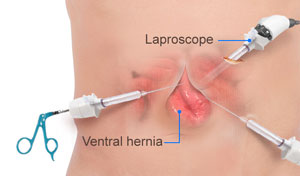Hernia Repair Surgery

A hernia is a bulge or protrusion of an organ or fatty tissue through a weakened area in the muscle or connective tissue in which the organ is enclosed. A hernia can develop in any part of the body. However, the muscles of the abdominal wall are most commonly affected. Hernia can occur in babies and in adults. Hernia repair surgery is the standard treatment.
Types of Hernia
There are many types of hernia that are classified based on their anatomical location.
The common types of hernia include:
- Inguinal: part of the intestine protrudes through the lower abdominal muscle into the groin
- Femoral: fat tissue or part of the intestine protrudes through the abdominal muscle into an area below the groin.
- Incisional: tissue protrudes through a previous surgical wound, which becomes structurally weak
- Umbilical: fat tissue or part of the intestine protrudes through the abdominal muscle near the belly button
- Hiatal: part of the upper stomach protrudes through an opening in the diaphragm into the chest region
Symptoms of Hernia
The symptoms depend on the type of hernia, its causes and the severity. The main symptom is the appearance of a lump (a swollen area) in the region involved. The lump may be painless and only be felt on exertion such as lifting heavy objects, coughing, etc. Some hernias can cause pain during exertion. The lump is not felt when the person is lying down; it becomes prominent on standing and particularly on straining. Some hernias can get strangulated, interrupting blood supply to the herniated tissue.
Diagnosis of Hernia
The doctor can usually diagnose a hernia by physical examination (for example: for inguinal hernia, a lump can be seen or felt in the groin).
Treatment of Hernia
Surgical repair is recommended for hernias that cause pain and other symptoms, and for irreducible hernias (structures cannot be returned to their normal locations) that are incarcerated or strangulated. Surgery aims at closure and repair of the muscle wall through which the hernia protrudes.
In patients not fit for surgery a TRUSS, a non-surgical measure, a supportive device to keep the protrusion in place could be used.
However, surgical repair is recommended for hernias that cause pain and other symptoms, and for irreducible hernias (structures cannot be returned to their normal locations) that are incarcerated or strangulated. Surgery aims at closure and repair of the muscle wall through which the hernia protrudes.
Open surgery
Open surgery, also called Herniorrhaphy, for hernia is done under general anaesthesia. Your surgeon makes an incision of about 5-10cm long (depending on the size of the hernia) to view and access the surgical site. Your surgeon pushes the part of the intestine that protrudes back into its normal position and repairs the weakened muscle layer by sewing the edges of the healthy muscle wall together. A synthetic mesh is often placed and sewn over the weakened area to provide additional support and strength, by a procedure called hernioplasty. The incision is closed after the procedure using dissolvable stitches.
Laparoscopy
Laparoscopy, also called keyhole surgery, is a less invasive surgical method that uses a laparoscope (a small thin tube with light and a tiny video camera connected to a television monitor), which helps visualise the internal organs during the operation.
The surgery is performed under general anaesthesia. The surgeon makes small incisions through which the laparoscope and other surgical instruments are inserted. Carbon-dioxide is injected into the abdomen to inflate the abdominal cavity, enabling your surgeon to better visualise the internal organs. Your surgeon repairs the hernia using a synthetic mesh by placing it over the weakened area. Once the procedure is completed, the small abdominal incisions are closed with stitches or surgical tape.
Advantages of a laparoscopic procedure over the open surgical method include shorter hospital stay, small incisions, less post-operative pain and faster recovery. You can resume normal activities in a few days.
Post-operative care for Hernia
Following surgery, you
- Can take a shower only after 48 hours post-surgery
- Can go home the day of the procedure
- Should avoid driving while taking pain killers as they induce drowsiness
- Can resume daily activities slowly while strenuous activities should be resumed only after consultation with your surgeon
- Use ice pack on the wound to reduce pain, prevent swelling and to lessen bloody discharge from the incision if present
- Recover in about 3 weeks
Risks and Complications of Hernia Repair
Like most surgical procedures, hernia repair is associated with the following risks and complications:
- Reaction to anaesthesia
- Infection
- Bleeding at operation site
- Nerve damage and numbness of skin
- Damage to surrounding tissue
Although the recurrence of hernia is seen in less than 5% of patients after surgery, you would need to follow preventive measures.








